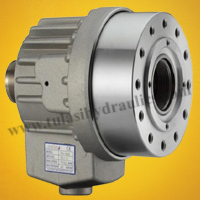Hydraulic Rotating Cylinder
Tulasi Hydraulic Pvt.Ltd. is a distinguished Manufactures and Suppliers of advanced Hydraulic Rotating Cylinders , strategically based in Mumbai, with operations extending toNavi Mumbai and Thane . As a reliable Provider and Exporter, we specialize in fabricating high-performance hydraulic solutions tailored to meet the varied needs of our clients across industries. Our Manufacturing company is committed to producing durable and efficient products, establishing us as a preferred Dealer in the hydraulic equipment market. With a focus on quality and innovation, Tulasi Hydraulic Pvt.Ltd. continues to excel in serving customers throughout India and beyond.
A hydraulic rotating cylinder, also known as a hydraulic rotary actuator or hydraulic rotary cylinder, is a type of hydraulic actuator designed to provide controlled rotary motion or torque in various industrial applications. These cylinders convert hydraulic pressure into mechanical rotary force, allowing them to rotate attached equipment or components. Hydraulic rotating cylinders are commonly used when precise and controlled rotation is required. The cylinder housing is the main body of the hydraulic rotating cylinder. It contains the internal components and provides structural support. The housing is designed to rotate around its central axis. Hydraulic rotating cylinders have hydraulic ports for the inlet and outlet of hydraulic fluid. These ports control the actuation and release of the cylinder, allowing hydraulic pressure to be applied to specific chambers to achieve rotation. Inside the cylinder housing, there is a rotating shaft that is connected to the load or component that needs to be rotated. The rotating shaft extends through one or both ends of the cylinder and is responsible for transmitting the rotary motion. The piston is an internal component of the hydraulic rotating cylinder. It is connected to the rotating shaft and divides the cylinder's internal chamber into two or more sections. When hydraulic pressure is applied to one side of the piston, it generates torque and causes the cylinder to rotate. Hydraulic rotating cylinders are equipped with sealing mechanisms to prevent hydraulic fluid leakage during operation.
Seals are essential to maintain the integrity of the hydraulic system and ensure efficient rotation. Hydraulic rotating cylinders are typically controlled using hydraulic control valves that regulate the flow of hydraulic fluid to the cylinder. These valves allow operators to control the speed and direction of rotation. Hydraulic rotating cylinders can be mounted in various orientations and configurations to accommodate different rotational requirements. Common mounting options include flange mounts, foot mounts, and clevis mounts. Bearings are often incorporated into hydraulic rotating cylinders to reduce friction and allow for smooth and efficient rotation of the shaft. These bearings help support the load and ensure the longevity of the actuator. Hydraulic rotating cylinders are used in conveyor systems and material handling equipment for controlled rotation of components. They are found in construction equipment such as excavators, backhoes, and cranes for tasks that require controlled rotation, such as boom and bucket movement. Hydraulic rotating cylinders are used in manufacturing processes, including machine tools, welding equipment, and assembly lines, to provide controlled rotational movement They are employed in marine equipment like winches and anchor systems for controlled rotation. Hydraulic rotating cylinders are used in aircraft control surfaces and landing gear systems. They can be found in automotive assembly lines and testing equipment for tasks that require precise rotation. They are used in drilling equipment and wellhead control systems for controlled rotation.

Application :
- As per ISO Standard
- Tierod construction as well as welded construction.
- Min. bore O 25 mm to Max. bore 5771 mm.
- Working pressure. a) 140 kg/cm2, b) 350 kg/cm2
- Stroke length upto 6.5 metres
- Telescopic cylinders as per customer’s requirements.
- Cylinders available. In S S For Pharmaceutical Machinery.



